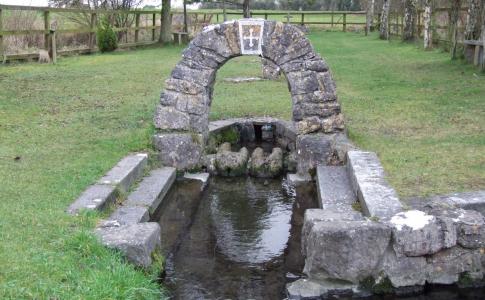Saint Brigid: Life, Legend, and Cult
Noel Kissane (Four Courts Press, €24.99)
Padraig Ó Riain
In the Life he wrote for Brigid, Cogitosus, the earliest known Irish biographer of a saint, declared that because of her, Kildare’s authority extended “from sea to sea”, from one side of Ireland to the other.
Judging by the dedications to Brigid listed in this book by Noel Kissane, province by province, county by county, Cogitosus’ words certainly applied to Kildare’s patron saint.
Devotion to her extended from the south coast of Co. Cork, where there are four dedications, to the Inishowen peninsula in Co. Donegal, where two medieval churches bore her name. From Clare Island in West Mayo to Killossery parish in north Co. Dublin, where the local townland of Brazil is named after her family, the Uí Bhreasail, her memory was similarly cultivated, as also at Killester, and at St Bride’s church near St Patrick’s cathedral within the medieval town of Dublin.
Alas, the author’s native county of Kerry is one of the few that are poorly provided with dedications to the saint; under churches he list’s one only, at Duagh near Listowel.
Recommendation
Noel Kissane’s interest in the saint arose by accident; on the recommendation of his supervisor in UCD, the renowned Patrician scholar Ludwig Bieler, he chose her Latin metrical Life, written about 850 by Donatus, an Irish bishop of Fiesole, as the subject of his doctoral thesis.
Beautifully situated in the hills above Florence, Fiesole is now adjoined by a village and church of Santa Brigida, and further north, in Piacenza, near Bobbio, is another Santa Brigida, founded to provide hospitality for Irish pilgrims.
Numerous overseas dedications to the saint are listed by the author, beginning with England, Wales and Scotland. While particularly strong in Britain’s Celtic fringes, her cult was also cultivated among the ancestors of the present-day English. Indeed, one English dedication, a well in London, left its mark on the English language, in the word bridewell, which recalls a holy well in the City of London, located near a prison (formerly a royal residence of Henry VIII).
The continental traces of the saint listed here should be of particular interest to those travelling on educational or leisure trips abroad. A 13th-Century Irish poet quite properly described Brigid as ógh na hEorpa, ‘Europe’s virgin’; in medieval times, it is doubtful if any other non-biblical virgin was venerated as widely.
There are many question-marks still hovering over the record of the saint. Was she born at Faughart, near Dundalk, as Louth people maintain?
Or was this belief the result of (deliberate) confusion between Fothairt, Brigid’s people south of Kildare, and Fochairt, the Irish form of Faughart? And is she buried in Kildare, or, as many came to believe, at Downpatrick in the exalted company of Patrick and Colum Cille?
The evidence for each of these beliefs is discussed by the author. Perhaps the greatest question-mark hanging over Brigid’s record is whether she ever existed as a real person, a subject to which many pages are devoted.
Several scholars, including the present reviewer, are of the view that she was a Christianised version of a pre-Christian divinity whose cult was widespread among the Celtic peoples. But Noel Kissane joins other scholars in the view that, on the balance of probability, Brigid was a real person.
With the exception of Patrick, no other saint has been the subject of as many biographies, beginning with Cogitosus, and continuing with several anonymous biographers down to the 12th Century, when an Englishman, Laurence of Durham, compiled a very polished version of her Life.
The 16th and 17th Centuries witnessed a revival of interest in the saints, and the Louvain Franciscan John Colgan devoted 125 folio pages to Brigid in his Trias Thaumaturga (1647).
A second revival of interest took place in the late 19th Century, as is shown by over 200 pages being devoted to Brigid by Laois-born priest Canon John O’Hanlon, the energetic litterateur and painstaking scholar of the diocese of Dublin, in the February volume of his Lives of the Irish Saints (1875).
Noel Kissane’s book of over 350 pages details her story and the influence it has exercised, from earliest times down to the many modern reminders of the saint, in names of churches, parishes, townlands, schools, religious orders, and secular associations, including numerous GAA clubs.
As the author shows, wherever the Irish have gone, from earliest medieval times on the continent to modern times worldwide, devotion to Brigid has accompanied them.
By devoting what amounts to a lifetime of research to Brigid, while also engaged on his duties as Education Officer and Keeper of Manuscripts in the National Library, Noel Kissane has paid a handsome tribute to Ireland’s national female saint, Mary of the Gaeil, who, as is said in an Old Irish poem, sits “safely enthroned, triumphant upon the side of Liffey, as far as the strand of ebbing sea”.
Padraig Ó Riain is Professor Emeritus of Old and Medieval Irish at UCC.


 St Brigid's Well in Kildare, an ancient shrine
St Brigid's Well in Kildare, an ancient shrine 